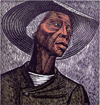How Nell Irvin Painter Illustrated Creating Black Americans
Nell Irvin Painter’s Creating Black Americans is destined to become one of the most beautiful history textbooks in recent memory, with roughly 150 creative representations of the African-American experience ranging from painting and sculpture to graffiti art and quilts. Most of the images are in stunning color, some of them filling an entire page. (I’ve done what I can to show the sample images in this post in the best light while keeping bandwidth low, but they don’t do the printed versions justice.) I asked Prof. Painter, who only recently retired from teaching after running Princeton’s African-American History department, how she chose the images to accompany her work.
Creating Black Americans works beautifully as a finished product, but I was feeling my way as I wrote. You see, I’m an American historian, not an art historian. So most of my preparation went into the narrative text, into the job of getting the history right. Even so, over time, dealing with the images grew into a bigger and bigger task. Toward the end of the work, permissions demanded what seemed like an infinity of time: tracking down artists or their agents or their executors, and getting them to reply with permission and usable images. That was how my work with illustrations ended. It started with my deciding which art to use.
I had begun with the decision to relate the illustrations to the major theme of the book: black people’s own creativity. That meant that all the artists would be African-American. Then there was the fundamental fact that Creating Black Americans is a history book. The artwork had to relate to historical themes in African-American history. Those two imperatives separate Creating Black Americans from art history, despite my book’s wealth of art.
Even within those limitations, I found much more art than I could use, except in three chapters. The themes of the Atlantic slave trade, the Civil War, and Reconstruction have not yet produced the gorgeous abundance of more favored themes such as ordinary working people and racial violence. Two examples from my book are Elizabeth Catlett’s “Sharecropper” (1968, left) and David Hammons’s “Injustice Case” (1970, right).
Black artists have been making images of the last two themes throughout most of the twentieth and into the twenty-first centuries, often integrating American flag motifs, as Hammons does around the frame of “Injustice Case.” Only recently, however, have black artists turned to the Atlantic slave trade and the Civil War. Faith Ringgold’s “We Came to America” (1997, left) provides one example; John Jones’s “The New Order” (1998, below) provides another, in which General Robert E. Lee finds himself confronted with General Colin Powell. Reconstruction still awaits full visual treatment.
My approach was eclectic, limited only by what real art historians and curators had already selected as important works of art. I ransacked books of art history and journals, such as Richard Powell (Rhapsodies in Black: Art of the Harlem Renaissance), Carolyn Mazloomi (Spirits of the Cloth: Contemporary African American Quilts), and the International Review of African American Art. I wanted to show as wide a range as I could of black art on historical themes, and as many artists as possible, whether academically trained or self-taught, whether working in oils, metal, cloth, wood, or subway cars. Not having come through formal training, I was free to mix media and artists with ignorant abandon. The actual process of making the book did eventually curb my freedom, however.
Reluctantly I decided to limit my use of abstract images, even though African-American artists have turned increasingly to abstraction in recent decades. The problem with abstraction is interpretation: For most readers, abstraction demands explanation, but for me, extended explanation of the artwork commandeered valuable space in the text. Faced with the choice between words dedicated to the art or words dedicated to the history, I decided for history.
During the process I must have sorely tried the patience of those working with me, and I swore more than once never to undertake so hybrid a book. But now, with the book in my hand and my readers’ gushing over the final product, I just about conclude the pain was worth it.
29 November 2005 | guest authors |


 Our Endless and Proper Work is my new book with Belt Publishing about starting (and sticking to) a productive writing practice.
Our Endless and Proper Work is my new book with Belt Publishing about starting (and sticking to) a productive writing practice. 
